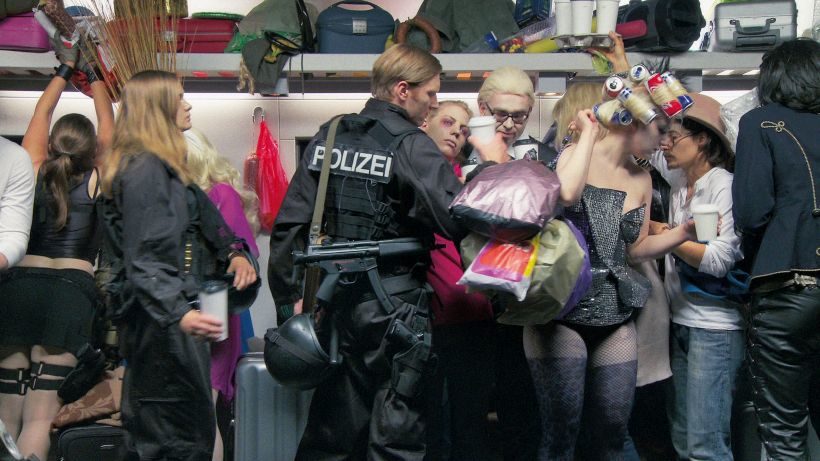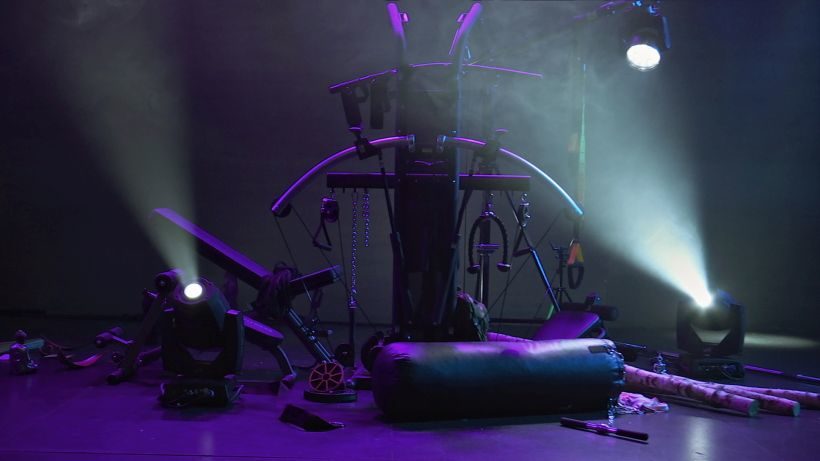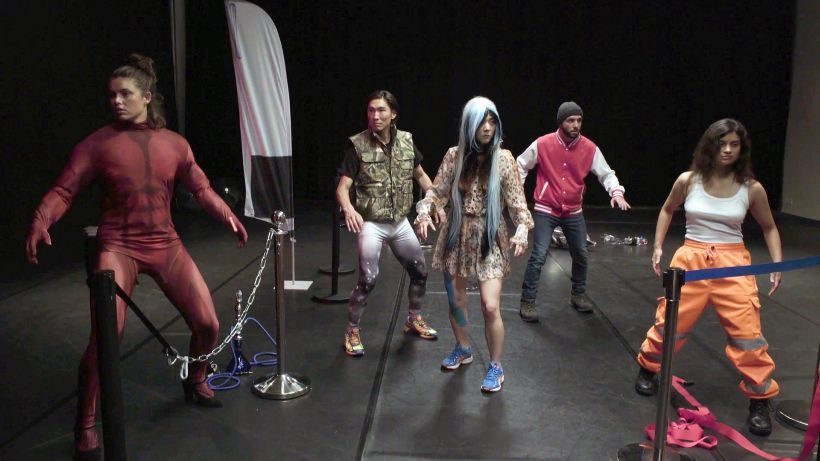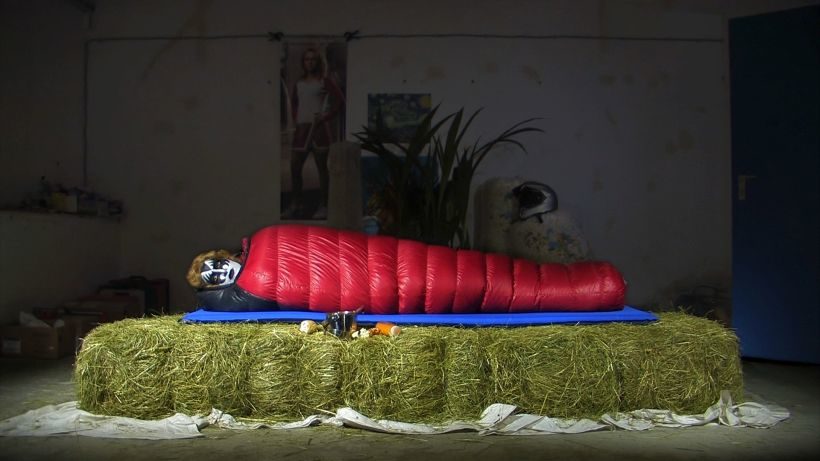
SORRY, 2010, HD, colour/sound, exhibition loop 8:08 min. / screening version 9:35 min., single channel © Stefan Panhans
Since the beginning of the 2000s, Stefan Panhans has made a name for himself with works that refuse to be clearly assigned to an artistic genre or field of practice and entwine still and moving, as well as found and newly created images and spaces within constantly changing constellations. Doing so, he works with photography in which filmic plots are intimated, video installations that merge elements of theatre and computer games, texts that evolve like fictions you can enter, and performances that become films. He produces images of a present that is defined by the rhythms of goods and media consumption, that prefabricates their promises of salvation in the form of advertising, therapies and lifestyles and, doing so, fans the desires for the authentic and the immediate at the same time, and lets them ossify in their own clichés.
In a manner similar to how the works themselves never seem to come to rest within a single artistic form, the same is true for the characters that populate them between differing degrees of passivity and action, euphoria and torpor, always seeking the next level. Taking a fitness studio, the video GLOW (2006) provides the perfect setting for such filmic stagings: A young woman in sports gear is training on a cross-trainer, energetically working out on the spot. Doing so, she ducks aside again and again as though she is being shot at by an unseen sniper, yet without interrupting the rhythm of her training routine. Only the beeping of her pulse watch causes her to stop occasionally to check the feedback. With the sound also being emitted directly via her headphones: Are those mantras she is endlessly repeating in a mumble intended to overcome her own shortcomings? A hydration backpack completes the exoskeleton of devices and equipment with which her body is armed in the battle for survival. And it appears that the armament here is equivalent to that for normal use.

NOCH EIN SPORTSTÜCK, 2014, HD, colour/sound, 13:43 min.,16:9, single channel © Stefan Panhans
In NOCH EIN SPORTSTÜCK (2014), Panhans weaves this short-circuiting of sports and war further in an obvious allusion to Elfriede Jelinek’s EIN SPORTSTÜCK, but reverses the perspective doing so: The focus here is not on the human bodies training themselves and shaping up, but rather on the machines for that very training. In a darkened space that could be a stage, club or gym at one and the same time, training equipment and moving lights are arranged in a central sculptural group that is being illuminated by the alternating light effects and circled by a moving camera. Drones and searchlights are at least intimated as military technology and also permit the appearance of war equipment to be discerned in this fitness machinery hall. Accompanied by their own techno music – the sounds of the machines’ performances before the camera and fragments of mainstream film scores from the internet – these machines seem to be immersed in a kind of dance, released from their service to humankind, while their ready-to-serve armoured bodies are, for once, even able to devote themselves to pure contemplation. A Buddha figure positioned at random bestows a smile. In this adaptation, not only does Panhans permit the separation of work and free time to merge within an ambivalent performance concept, he also indicates a reallocation of attributes such as “enlivened” and “lifeless”, whose clear identification with the human-like on the one hand and the machine-like on the other is apparently in the process of becoming dissolved.

FREEROAM À REBOURS, MOD#I.1, 2016, 4K, colour/sound, 16:13 min. single channel © Stefan Panhans
In Panhans’ most recent video work FREEROAM À REBOURS, MOD.#I.1 (2016) this dissolution becomes something that can be experienced as a movement unfolding within a filmic space: Computer game avatars from “Grand Theft Auto” and their human doubles are moving through a world that is permanently alternating between real and virtual cityscapes and constructed stage settings. Unlike in his earlier videos, in which the plots unfolded in statically framed sets with stage-like arrangements, Panhans works with abrupt changes in perspectives here and a rambling, disembodied moving camera that not only takes up visual narrative forms from computer games, but even permits direct interaction with the players, stimulates action or reacts to it.
Panhans has edited together two parallel “worlds” or levels of reality here in such a way that the border between both becomes increasingly elastic and permeable. The assumed primacy of the real world over the virtual game world begins to waver the more we find that same architecture of invincibility and adventure we know (or believe we know) from computer games reproduced in our present. And even the avatars are no longer merely virtual reproductions of people, whose angular bodies and movements mark them forever as being different; instead, we stretch their skins over us as a fashionable outer shell, transforming their otherness into our own – and with that their endless changeability and vitality as well.
In the action-fixated logic of the computer game, moments of stillness are not intended – in a way similar to that in our everyday world. Any hesitation, stopping or inability on the part of the game player leads to those strangely hesitant dangling movements, repetitive idling or faulty motion patterns of their avatars that Panhans lets his human and virtual actors perform again and again, thus proffering this as a subversive gesture: As (im-)mobilisation against a social consensus that has elevated the “always onward, upward, further” to the utmost rule of the game. Panhans discovers the traces of a dance-like language in those everyday movements that are no longer found on the streets of New York, but rather in the urban canyons of “Grand Theft Auto”. In this way, he situates the possibility of resistance not in the liberating of the human body from the shackles of technology, but rather in the appropriation of its imperfection.
Panhans’ first novel WE JUST LEFT SHORE (2017) was also penned parallel to FREEROAM. It expands upon his confrontation with the narrative forms of films and computer games on a literary level. The first-person narrator moves as a kind of participative observer, who is alert but at the mercy of the events and frequently close to impotence, through non-stop and abruptly changing scenes, in which fragments of everyday experiences are overlaid with memories, cinematic images, computer game sequences, advertising, music and game shows, and is thus reminiscent of that alogical movement in dream sequences removed from time and space. His narrative seems to unfold spatially, conveying through the eye of a virtual camera the parts of a world or the imaginings of the first-person narrator that are to be seen, zooming in and out, in motion, yet always being led on by an alien entity and even failing in its duty at times: “Perhaps someone has to pay something now so it continues.” The events and incidents flow like data, sometimes better, sometimes worse. And even the language seems to be remote-controlled, being manic and mechanical at one and the same time in a way similar to that in Panhans’ earlier videos, in which speaking becomes a quasi-automatic, occasionally faltering stream of language for which the characters serve merely as amplification.

IF A STORECLERK GAVE ME TOO MUCH CHANGE, 2009, HDV, colour/sound, exhibition loop 2 x 15 min. / screening version 15 min., 16:9, single channel german / english spoken, english subtitled © Stefan Panhans
In IF A STORE CLERK GAVE ME TOO MUCH CHANGE (2009), for instance, a person with black and white face painting à la Kiss is lying stretched out in a bright red mummy-shaped sleeping bag that is resting upon a row of hay bales in the middle of a sparsely furnished and somewhat rundown room – half-bedroom and half-cellar. As though automatically, the person begins to utter text passages in alternating vocal pitches and intonations, turning to us at times and at other times to the ceiling. The text passages themselves are obviously borrowed: From Facebook posts, the German Federal Travelling Expenses Act, advertising, features about dinosaur and personality tests. In this horizontal, quasi-floating state, the texts are able to stream through unhindered without becoming entangled in their references to the person or the objects. This language says nothing about the world, and instead it takes its place. It is unimportant which highly desirable product an advertising slogan names, because the naming itself is already as good as the thing; test results are not data but realities, and the mere talk of a wellness cure is enough to cure us. The figure speaking is the transition zone, within which the magical replacement of word with reality occurs. And the figure is not really there and not really gone: It is a mummy and a larva at one and the same time, already in the grave and still in the process of becoming. Its location is inside and outside at one and the same time, between the sounds of the jungle and the houseplants, in an outdoor outfit and ready for the stage. And, as is typical in Panhans’ videos, it will persist in this state of indeterminacy: Its actions being pure possibility.
In WHO’S AFRAID OF 40 ZIMMERMÄDCHEN (2007) we also encounter two such characters: A woman whose outfit indicates she is half-stewardess and half-traffic warden and a man with similarities to a tramp and a medieval freak are sitting at a campfire on the edge of a forest at night and waiting for something or someone. They could be participants in a roleplay who are whiling away their break with a relaxed chat – just that no one is chatting here. Instead, each of them is reeling off the exact same loop of disjointed text fragments for themselves, occasionally interrupted by messages being received “live” in an ongoing monologue. A trace of panic then becomes palpable, if at all, when something comes from outside without being asked and tries to penetrate into the inner circle of the campfire glow, be that just spam, a wild animal presumed to be in the forest or disturbed doshas that occupy the bodies: “Egest them. Out, out.” And yet this defensive attitude seems strangely half-hearted because, do we not actually want to be occupied? Does possessing not always also mean becoming occupied, becoming colonised by one’s own desire for possessing?
In THE BEST ONES MAKE YOU FEEL AS FEARLESS AS BEYONCÉ (2015), the world is shrunk to the dimensions of an SUV, filled to the brim with all kinds of things, from fitness and electronic equipment to items of clothing (some traditional, some sporty) and medicaments, through to a shrink-wrapped piece of ham. In the car’s dark interior, an action-cam is tentatively stroking across the surfaces of the objects, accompanied by a breathless off-screen narrator’s voice that alternates between a stocktaking of its own sense of being dissolved, the analysis of possible causes and a catalogue of therapy options: You have to fall in love again properly once more! And get out of here no matter what. The appeal of seeking the vastness, or of seeking healing in the vastness, the real life, is something we encounter repeatedly with Panhans in images of the (domesticated) beauty of nature – in the implied edge of the forest in 40 ZIMMERMÄDCHEN, in the houseplants and hay bales in IF A STORECLERK…, in the sawn-off tree trunks in NOCH EIN SPORTSTÜCK, or in a waterfall here that bookends the video and gives it a framing. And even the SUV is not intended to summon up anything other than an off-road feeling in the big-city traffic. This yearning, which can only be articulated in clichés of “clarity”, “intensity” and “deceleration”, ultimately releases itself in a poignantly melancholy song, the lyrics of which, however, as we surmise on a more exact hearing, are compiled yet again from anonymous phrases.
The view into the passenger compartment is a view into the inner life of our present time, a parcours through the imaginings and desires that circulate, illustrate and are discussed within it so long until we accept them to be true – just like we assume a banknote is genuine when it is especially worn out and been passed through many hands. Panhans’ works impressively adapt these feedback loops of a self-stabilising consensus – although a kind of shifting is implied in his most recent creations here. For instance, Panhans’ latest work, the performative piece created together with Andrea Winkler and titled HOSTEL SEQUEL #1: PLEASE BE CAREFUL OUT THERE, LISA MARIE – HYBRID VERSION (2018) – a combination of video projection, installation and live reading that results in turn in a new video work – also feeds itself more powerfully from the experiences of the three performers compared to earlier projects: In a stage setting that suggests an overcrowded multi-bedroom in a hostel, they are speaking a text that, in addition to narrated dreams and celebrity news, also reflects fragments of their own experiences with racism and exploitive working conditions in the world of art, film and theatre.
A society is reflected in their utterances that not only is entirely absorbed in the compulsive consumption of information and goods, but for whose continuance becoming consumed by that system which circulates the information and goods in the first place is a necessary prerequisite. And while the battle about who is consumable within this system is being fought out more and more ruthlessly and being played out directly on bodies, the resistance to it is forming: In Panhans’ latest work, this resistance is no longer wordless – as a faltering or a stammering – and instead articulates itself as dissent: The restlessness of the form that energises his works more than ever and runs counter to every commitment to this genre or that kind of artistic practice is a symptom of this resistant movement.
1 Trackback